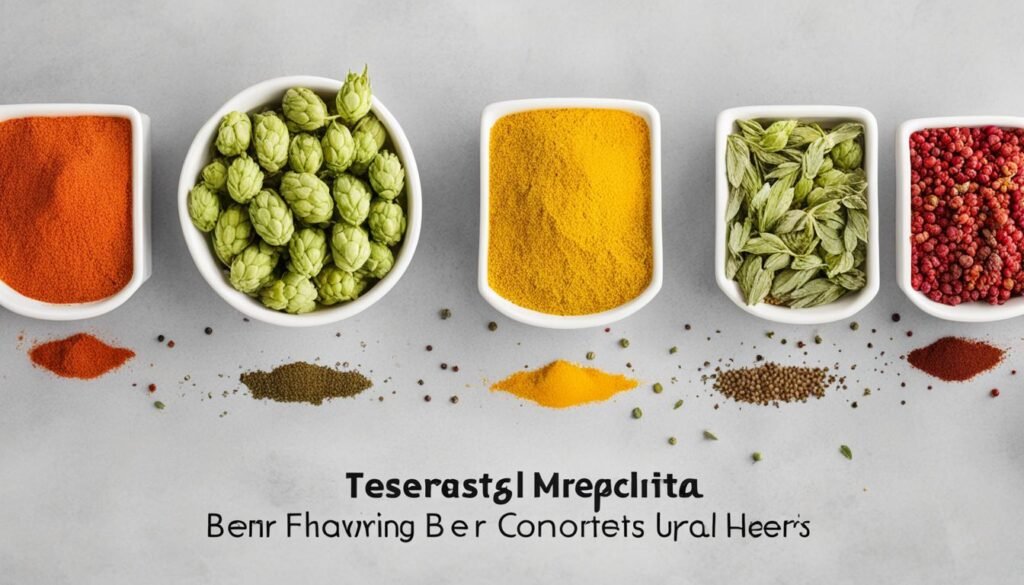Starting our journey into beer flavouring shows us how expert advice can change our brewing. It doesn’t matter if we’re new or experienced at brewing. Learning about beer flavouring can make our craft beer stand out. We’ll look at how to design beer recipes and the key ingredients that add flavour.
We’ll focus on finding the right balance in brewing. This way, our beers will be more exciting and full of flavour. Each bottle will be a perfect mix of tastes.
Want to know more about making great beer recipes? Check out this helpful guide: understanding key techniques. It will help us improve our brewing skills with proven methods.
Key Takeaways
- Expert advice on beer flavouring can elevate the taste of craft beer.
- Effective recipe design principles are essential for crafting memorable brews.
- Understanding the role of ingredients is vital for achieving balanced flavours.
- Utilising various brewing techniques enhances the overall beer aroma and taste experience.
- Experimentation with different batch sizes allows for greater creativity and variety.
Understanding the Fundamentals of Beer Recipe Design
Grasping the core principles of beer recipe design is key in our brewing journey. Setting a focused goal helps us develop our recipes better. For example, aiming for a light-bodied pale lager means choosing the right ingredients and methods.
Setting a Focused Goal for Your Brew
Having a focused goal helps us pick the right ingredients. Each ingredient is crucial for the flavour. The Beer Judge Certification Program (BJCP) offers guidelines for over 100 beer styles. Knowing these styles helps us choose the right malt, hops, and yeast.
The Importance of Simplicity in Recipe Creation
Simplicity is key in beer recipe design. Using only what we need keeps the flavours balanced. This lets us focus on improving key elements that make our beers unique.
Research helps us here; looking into beer styles’ history and ingredients leads to better recipes. For more tips, check out beer recipe designs.
Balancing Ingredients: Hops, Malt, and Yeast
Getting hops, malt, and yeast in balance is crucial for a great beer. Knowing how these elements work together prevents one from overpowering the others. Key factors like Original Gravity (OG) and Final Gravity (FG) help us understand the beer’s alcohol and flavour.
Measuring bitterness in International Bitterness Units (IBUs) and colour with SRM keeps the balance right. This way, each ingredient supports the others, making for a drinkable beer.
Exploring Key Brewing Ingredients
In making beer, we use four main ingredients: water, malt, hops, and yeast. Each one is vital for the taste and character of our beer. Knowing about these ingredients is key for home brewers. They shape the beer’s taste and make each brew unique.
By learning about hops, malt, and fermentation, we can improve our brewing. This knowledge helps us make better beer.
Role of Hops in Beer Aroma and Bitterness
Hops are crucial for the smell and bitterness of beer. Different hops can add floral, citrus, or earthy flavours. The climate and soil where hops grow can change their taste. Using the right hops can make our beer stand out.
For more tips on home brewing, see this guide to home brewing.
Understanding Malt Varieties and Their Flavours
Malt is key for the beer’s body, colour, and taste. Starches turn into sugars during malting, which yeast ferments. There are many malt types, each adding flavours like caramel or chocolate.
Choosing the right malt lets us control the beer’s sweetness and colour. For example, pale malt gives a clean taste that works well with many beer styles.
Fermentation and Its Impact on Beer Taste Perception
Fermentation changes sugars into alcohol and shapes the beer’s character. The yeast we use affects the alcohol level and flavour. Yeast types like ale or lager yeast change the taste.
Understanding fermentation helps us make the flavours we want. This lets us try new ingredients and make unique beers.
| Ingredient | Role | Impact on Beer |
|---|---|---|
| Water | Base ingredient | Affects taste, clarity, stability |
| Malt Varieties | Source of sugars | Contributes to sweetness, colour, and body |
| Hops | Aroma and bitterness | Balances sweetness, adds flavour complexity |
| Yeast | Fermentation agent | Defines character, influences flavours |
Beer Flavoring Techniques to Elevate Your Brews
In the world of brewing, mastering beer flavouring techniques makes a big difference. Using fresh ingredients and new methods lets us make unique beers. We can create brews that show off our skills. This section looks at how fresh ingredients boost flavours, adding honey and spices, and the impact of brewing techniques.
Using Fresh Ingredients for Enhanced Flavour
Adding fresh ingredients like herbs, spices, and citrus can change a beer’s taste. These natural tastes add complexity and freshness. For example, a special herb can give a beer unique traits, making it more enjoyable.
Using tinctures is a great way to control the flavour. Tinctures use strong liquors to quickly get flavours from spices. This is better than adding spices during fermentation.

How to Incorporate Additional Flavours, like Honey and Spices
Adding honey or spices can make our beers richer. It’s important to use the right amount, like 1 to 1 with honey or maple syrup. This keeps the beer balanced.
Adding tinctures slowly during bottling helps fine-tune the taste. Start with a little and adjust as needed. This way, you can get the taste just right without overpowering the beer.
The Impact of Brewing Techniques on Overall Taste
The way we brew affects the taste of the beer. Changing mash temperatures and controlling boil times changes how flavours come out. We need to think about how things like filtration or pasteurisation might change the flavours over time.
Adding concentrated flavourings at the end, like liquid flavourings or extracts, can boost the aroma and taste. Paying attention to these details makes the beer better for drinkers.
By using these beer flavouring techniques and focusing on quality ingredients, we can make our craft beers amazing. Brewing lets us try different tastes and show off our creativity and hard work.
For more on brewing challenges, including traditional recipes like Umqombothi and regional flavours, check out this detailed resource.
The Brewing Process: Timing and Temperature
The brewing process is all about timing and temperature control. Each step, from mashing to fermentation, needs our focus for the best flavour. By getting these right, we can make beer that meets our taste goals.
Importance of Correct Mash Temperatures
Getting the mash temperature right is key in brewing. We mash at 149-158°F (65-70°C) to help enzymes turn starches into sugars. This affects the beer’s body and feel. Later, yeast works best at 80-90°F (26-32°C) during fermentation. If it gets too warm, it can make unwanted flavours.
Boil Times and Their Effect on Flavour Extraction
Boil time is also crucial. Longer boils bring out deeper flavours and bitterness. It’s important to know how long to boil different hops for the right taste. Some yeast types, like Belgian or saison, are easy to work with and don’t need strict temperature control.
Cooling Methods to Preserve Aroma
After boiling, we need to cool the beer to keep its aroma. Using a wet T-shirt to cool the fermenter helps. Or, we can use temperature controllers or second-hand fridges to keep costs down. Learning about brewing history in South Africa, like this resource, can also help us improve our brewing.
FAQ
What is the importance of beer flavouring in craft beer production?
Beer flavouring is key in craft beer as it makes the drinking experience better. By using different flavouring methods, we can make unique beers. These beers will thrill the taste buds and leave a lasting impression.
How can we design a beer recipe effectively?
To design a beer recipe well, start with a clear goal for your brew. Choose your ingredients carefully and balance hops, malt, and yeast. This keeps the flavours in check and makes the beer enjoyable.
What role do hops play in beer production?
Hops are essential for adding aroma and bitterness to beer. Each type of hop brings its own flavour and effect. This lets us shape our beers to our liking and achieve the taste we want.
Why is understanding malt varieties important?
Knowing about malt varieties helps us create specific tastes in our beer. Each malt adds its own sweetness, body, and colour. These elements add to the beer’s complexity.
How does fermentation affect beer taste perception?
Fermentation is crucial in brewing. It turns sugars into alcohol, changing the beer’s flavour and smell. The yeast strain we use can also add unique tastes, shaping how we experience the beer.
What advanced techniques can we use for beer flavouring?
To improve our beers, we can use fresh herbs and spices, and other flavourings like honey. Learning about brewing methods helps us get the most out of flavours and create complex tastes.
How do timing and temperature affect the brewing process?
Timing and temperature are vital for the best flavours. Right mash temperatures help enzymes work well, while boil times affect bitterness and smell. Good cooling keeps the beer’s important smells intact for a full flavour.
